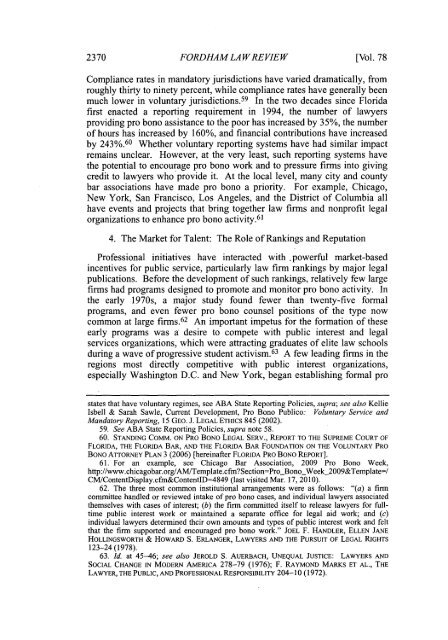Law for The Poor
Law for The Poor
Law for The Poor
Create successful ePaper yourself
Turn your PDF publications into a flip-book with our unique Google optimized e-Paper software.
2370 FORDHAM LA WREVIEW<br />
[Vol. 78<br />
Compliance rates in mandatory jurisdictions have varied dramatically, from<br />
roughly thirty to ninety percent, while compliance rates have generally been<br />
much lower in voluntary jurisdictions. 59 In the two decades since Florida<br />
first enacted a reporting requirement in 1994, the number of lawyers<br />
providing pro bono assistance to the poor has increased by 35%, the number<br />
of hours has increased by 160%, and financial contributions have increased<br />
by 243%.60 Whether voluntary reporting systems have had Similar impact<br />
remains unclear. However, at the very least, such reporting systems have<br />
the potential to encourage pro bono work and to pressure firms into giving<br />
credit to lawyers who provide it. At the local level, many city and county<br />
bar associations have made pro bono a priority. For example, Chicago,<br />
New York, San Francisco, Los Angeles, and the District of Columbia all<br />
have events and projects that bring together law firms and nonprofit legal<br />
organizations to enhance pro bono activity. 61<br />
4. <strong>The</strong> Market <strong>for</strong> Talent: <strong>The</strong> Role of Rankings and Reputation<br />
Professional initiatives have interacted with .powerful market-based<br />
incentives <strong>for</strong> public service, particularly law firm rankings by major legal<br />
publications. Be<strong>for</strong>e the development of such rankings, relatively few large<br />
firms had programs designed to promote and monitor pro bono activity. In<br />
the early 1970s, a major study found fewer than twenty-five <strong>for</strong>mal<br />
programs, and even fewer pro bono counsel positions of the type now<br />
common at large firms. 62 An important impetus <strong>for</strong> the <strong>for</strong>mation of these<br />
early programs was a desire to compete with public interest and legal<br />
services organizations, which were attracting graduates of elite law schools<br />
during a wave of progressive student activism. 63 A few leading firms in the<br />
regions most directly competitive with public interest organizations,<br />
especially Washington D.C. and New York, began establishing <strong>for</strong>mal pro<br />
states that have voluntary regimes, see ABA State Reporting Policies, supra; see also Kellie<br />
Isbell & Sarah Sawle, Current Development, Pro Bono Publico: Voluntary Service and<br />
Mandatory Reporting, 15 GEO. J. LEGAL ETHICS 845 (2002).<br />
59. See ABA State Reporting Policies, supra note 58.<br />
60. STANDING COMM. ON PRO BONO LEGAL SERV., REPORT TO THE SUPREME COURT OF<br />
FLORIDA, THE FLORIDA BAR, AND THE FLORIDA BAR FOUNDATION ON THE VOLUNTARY PRO<br />
BONO ATTORNEY PLAN 3 (2006) [hereinafter FLORIDA PRO BONO REPORT].<br />
61. For an example, see Chicago Bar Association, 2009 Pro Bono Week,<br />
http://www.chicagobar.org/AM/Template.cfm?Section=ProBonoWeek_2009&Template-/<br />
CM/ContentDisplay.cfmn&ContentID=4849 (last visited Mar. 17, 2010).<br />
62. <strong>The</strong> three most common institutional arrangements were as follows: "(a) a firm<br />
committee handled or reviewed intake of pro bono cases, and individual lawyers associated<br />
themselves with cases of interest; (b) the firm committed itself to release lawyers <strong>for</strong> fulltime<br />
public interest work or maintained a separate office <strong>for</strong> legal aid work; and (c)<br />
individual lawyers determined their own amounts and types of public interest work and felt<br />
that the firm supported and encouraged pro bono work." JOEL F. HANDLER, ELLEN JANE<br />
HOLLINGSWORTH & HOWARD S. ERLANGER, LAWYERS AND THE PURSUIT OF LEGAL RIGHTS<br />
123-24 (1978).<br />
63. Id. at 45-46; see also JEROLD S. AUERBACH, UNEQUAL JUSTICE: LAWYERS AND<br />
SOCIAL CHANGE IN MODERN AMERICA 278-79 (1976); F. RAYMOND MARKS ET AL., THE<br />
LAWYER, THE PUBLIC, AND PROFESSIONAL RESPONSIBILITY 204- 10 (1972).

















